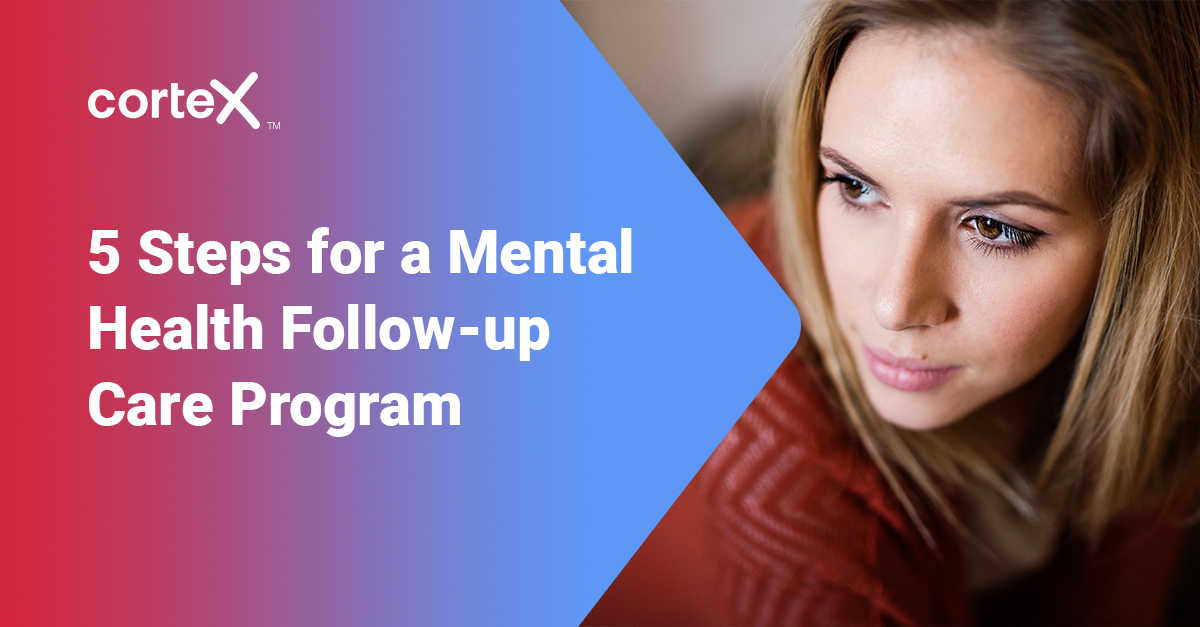When mental health patients are discharged, they enter an environment drastically different from the supportive care of a clinic or psychiatric ward. They often lack a support network and are unable or have low motivation to keep with continuing care.
This increases their risk of experiencing another crisis. In fact, suicide risk is particularily high in the first few weeks after discharge. A follow-up care program gives mental health patients the extra help they may require during the transition from inpatient to outpatient care.

Follow-up care is a cost-effective way to provide support to these patients, reducing the possibility of readmission or emergency room visits. It removes gaps in care and creates clear communication channels between care providers, helping a patient’s needs to be met appropriately. This article walks you through the process of creating a cost-effective follow-up program for mental health patients, outlined in five simple steps.
1. Create a patient follow-up care team
When you’re drawing up your follow-up care plan, it’s crucial to assign direct responsibilities. Many hospitals and clinics choose one individual or create a team to implement all follow-up procedures. Alternatively, you could partner with a private company like Cortex to fully implement and manage a program and then your teams concentrate on the critical alerts.
2. Define a general follow-up structure
Follow-up care should be viewed as a necessary part of service for all patients. When creating your program, consider these elements.
Establish program expectations before discharging the patient
A follow-up care program typically begins before the patient is discharged. Here you will obtain permission from the patient, the best way to contact them, and provide an overview of what to expect.
5 components of patient follow-up contact
The second point of contact should take place 24 to 48 hours after the patient is discharged. The Agency for Healthcare Research and Quality suggests that a follow-up phone call that consists of the following five components.
- Assessment of health status. Ask the patient questions in order to determine if their health has deteriorated since discharge. If yes, assess the severity of the deterioration and determine whether or not an intervention is required.
- Medicine check. Provide the patient education on their prescriptions and determine if they have been following the use of these drugs as directed. You should also check to see if the patient is experiencing any side effects or other problems.
- Clarification of clinician appointments and lab tests. Confirm any follow-up appointments the patient has scheduled, the purpose of the appointments, and whether the patient has transportation to those appointments.
- Coordination of post-discharge home services. Check that the patient has received any planned home services. If a caregiver has been planned, check that this person has been available as expected. If not, problem-solve with the patient to find an alternative caregiver or to reach out to community services for additional help.
- Review of what to do if a health or medical problem arises. It’s best practice to end the call by reviewing with the patient what to do in the event of a problem or an emergency. Review probable obstacles they may encounter and what to do in the case of each one, including how to contact the appropriate caregiver or care provider for help.
- Bonus! Evaluation of support and stability. Having a support network and a stable environment is essential to a patient’s successful recovery. Ask questions about the people involved in the patient’s life and the level of stability they experience on a day-to-day basis. Do they have friends that are a good influence during this time? Do they have regular social interaction with others? Have they secured a safe place to live? Are they eating regular meals?
3. Determine the method of communication
The steps described above work best in the form of a phone call. However, not all follow-up programs need to be as extensive as this. Follow-up contact can come in the form of a phone call, a short text message, a letter, a home visit, email communication, or a combination. Determine what resources you have available to invest in your program and this will influence its extensivity. You may also create varying types of care depending on the risk-level of the patient.
4. Personalize the care plan for the patient
An important component of creating a quality follow-up program is personalization. Before any follow-up contact is made, the patient’s health history should be reviewed. Making notations of any problems the patient is likely to encounter will be beneficial to the follow-up process.
Another consideration of personalization is interpreter services. Determine if the patient will need an interpreter before they are discharged from the hospital or clinic.
Lastly, consider the length or extensivity of the follow-up program based on the risk level of the patient. High risk patients, such as suicide attempters, may require more extensive follow-up care to help ensure that they enter an environment that’s conducive to recovery.
5. Document and communicate information among care providers
Be sure to document all communication with the patient and pass on any relevant information to the patient’s primary care provider. This step is vital in order to maintain a detailed record of the patient’s history.
When documenting follow-up care, it’s helpful to organize information systematically by using a HIPPA-approved medical record or a tool like Cortex CheckUp™. This will allow you to quickly glean insights from the call and it will be easy to refer back to and find specific information. It’s also extremely useful when transferring records to another provider.
For example, consider organizing documentation using the following elements:
- Quantitative call summary for regulatory purposes
- Patient’s risk level based on a standardized scale
- Current and potential concerns
- Summarized answers to standard questions (for example, the six components outlined in #2 of this article)
- Clear list current caregivers and their contact information
- A transcript or recording of the call
Improve outcomes with patient follow-up calls by Cortex Registered Nurses
Cortex’s CheckUp™ is a unique follow-up program that allows hospitals and clinics to track patients post-discharge. All calls are made by a national network of registered nurses. Follow-up data is utilized to provide insights that help predict and prevent readmissions, monitor real-time outcomes, and understand patient satisfaction across the care continuum. All documentation is kept in organized, HIPAA-compliant records that help reduce risk and liability and keep you compliant with government regulations.




